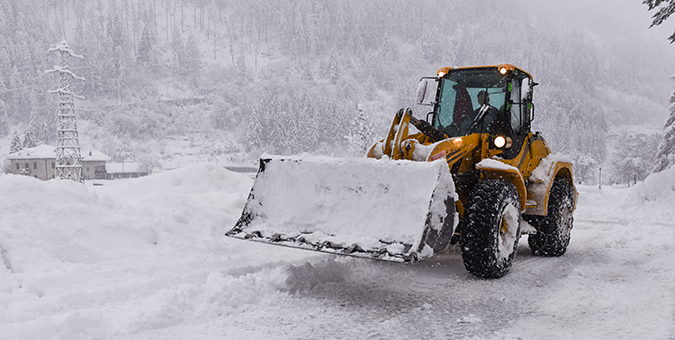Winter Safety: Protecting Employees from Underestimated Cold Weather Dangers

If your organization has employees who work outside during winter, read on to learn about four commonly underestimated cold weather hazards and how to mitigate their risks.
Author: Lisa Fade
January 31, 2024
The onset of winter brings unique challenges for your employees who work outside. While safety should always be a top priority, cold weather brings additional hazards that need to be addressed to ensure the well-being of your workforce. The experts at OSCAsafe look at four commonly underestimated winter health hazards and provide insights on effective strategies to mitigate risks.
Don’t Get Caught Out in the Cold – Pay Attention to These Four Hazards
#1: Freezing Temperatures
Cold stress can be a subtle, yet significant concern for outdoor workers during the winter months. Even if an employee is initially able to handle the exposure, there is the potential for them to misjudge the gradual effect the cold is having on them. The body’s gradual decline in core temperature might go unnoticed, creating a false sense of resilience.
Prolonged exposure to cold temperatures, wind, and damp conditions can result in serious health issues such as hypothermia, frostbite, and other cold-related illnesses. Minimize employee exposure during extreme cold spells by implementing a cold stress prevention program that incorporates these proactive strategies:
Encourage your employees to take regular breaks in warm areas to prevent prolonged exposure to the cold.
Equip workers with proper clothing designed for layering, ensuring they stay warm and protected.
Regularly monitor weather conditions and adjust work schedules accordingly. This proactive approach helps mitigate the risks associated with sudden changes in weather patterns.
#2: Low Visibility (Driving & Operating Equipment)
Winter conditions often result in reduced visibility due to factors such as fog, snow, and early evening darkness, posing a significant risk for workers operating equipment and those involved in transportation. This hazard is further magnified for pedestrians and individuals working around heavy machinery.
Inclement weather can arrive suddenly, catching us off guard, even on a seemingly clear day, increasing the likelihood of accidents and incidents. To reduce the risks associated with diminished visibility, consider utilizing these safety protocols:
Ensure adequate lighting around your facility to improve visibility during adverse weather conditions.
Mandate the use of high-visibility clothing for workers to enhance their visibility, especially in low-light conditions.
Conduct regular maintenance of vehicles, including headlights, and provide training on safe driving practices in winter conditions.

#3: Wet & Icy Conditions
In winter, standing water and snow can conceal tripping hazards, while the formation of ice creates slick conditions, significantly elevating the risk of slips, trips, and falls. At first glance, these hazards may not be apparent, leading individuals to proceed without taking the necessary precautions.
The often transparent and nearly invisible nature of the ice can make it a hidden threat, leaving workers vulnerable to unexpected accidents. What may appear as a mere wet or frosty surface can, in reality, conceal a sheet of ice that poses a significant risk of slips and falls. Not only can these incidents lead to immediate injuries, such as sprains or fractures, but they may also result in long-term health issues. To safeguard employees from these dangers, consider the following measures:
Provide employees with slip-resistant footwear to enhance traction on slippery surfaces.
Plan regular inspections of work areas to identify and address potential hazards promptly.
Schedule timely removal of ice and snow from walkways to maintain safe passage.
#4: Poor Hydration
While dehydration is commonly associated with hot weather, it remains one of the most underrated dangers during colder months. In lower temperatures, workers may not feel as thirsty, leading to inadequate fluid intake.
Additionally, the dryness of cold air and the use of moisture-wicking fabrics can contribute to unnoticed fluid loss through breathing and sweating. To address this often-overlooked hazard, educate employees on the importance of maintaining hydration levels and suggest the following preventive strategies:
Ensure easy access to a variety of both warm and cold beverages, as well as water-rich foods, to encourage regular hydration.
Encourage employees to establish water goals and track their water intake using timers or reusable marked water bottles.
Emphasize the importance of taking regular breaks, allowing employees time to rehydrate and maintain optimal fluid levels.
As you navigate the unique challenges presented by colder weather at your facility, prioritizing the well-being of your employees and fostering a proactive safety culture within the workforce is of primary concern. Staying vigilant is key. Through comprehensive training programs, preventive measures, and continuous monitoring, you can create a safer working environment.
The experts at OSCAsafe encourage you to utilize the outlined strategies for mitigating risks associated with four commonly underestimated winter health hazards. Valuing safety ensures a resilient and secure workplace through the often difficult winter months.
OSCAsafe is Here to Help
If your business needs an experienced partner who can deliver quality training programs and compliance management, OSCAsafe can help. Contact us to discuss tailored solutions for your business.
- cold weather hazards
- cold weather safety
- EH&S
- freezing temperatures
- health and safety
- health and safety programs
- health outcomes
- Icy Conditions
- injury prevention
- Low Visibility
- mitigate risk
- occupational health
- occupational healthcare
- oscasafe
- Poor Hydration
- safety
- safety class
- safety training
- winter dangers
- worker safety
- workforce safety
- workforce training

